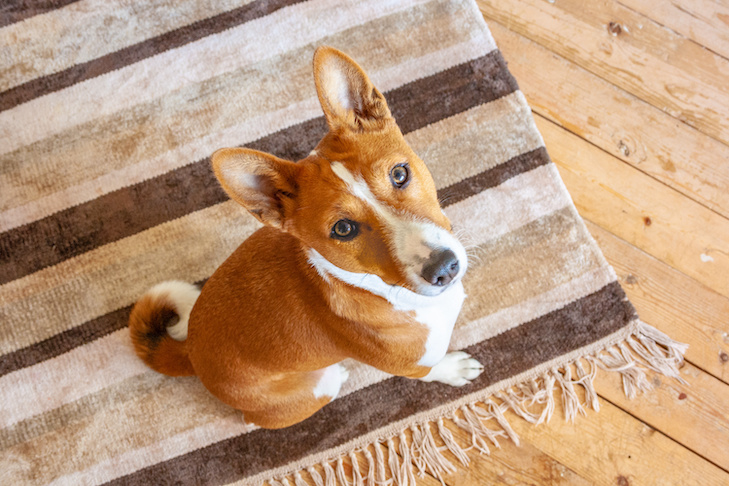AKC is a participant in affiliate advertising programs designed to provide a means for sites to earn advertising fees by advertising and linking to akc.org. If you purchase a product through this article, we may receive a portion of the sale.
When I first rescued my dog, “Annie,” she was riddled with anxiety as a result of a traumatic past.
Seeing this scared little soul, all I wanted to do was pick her up and shower her with all the love I felt she deserved. But what she actually needed in those first few months was space, a simple routine, and time to get to know and trust me on her own terms.
For many new owners, this approach can seem counter-intuitive. After all, there’s so much emphasis put on socializing new puppies and rescue dogs. But dog trainer and behavior consultant Mary Angilly, who works with high-risk rescued dogs, believes every new puppy or dog should have ample time to decompress when entering a new home.
Every Dog Is an Individual
For fearful or anxious dogs, it could take a few weeks or months for them to start feeling comfortable in their new home. On the other hand, some puppies who are appropriately socialized with a reputable breeder might only take a few days. They’re all unique, of course, but it’s unrealistic to expect any dog to arrive instantly well-adjusted and impeccably behaved.

Take it Slow
It’s tempting, especially for excited kids, to try to hug and play with a new dog immediately. “While [owners] might have the best intentions, new dogs have no idea where they are, who they’re with, or what is happening, and it takes time to build a positive relationship,” Angilly explains. “The more patient a [owner] is, and the more choice a dog is given over seemingly simple things, the faster trust will build.” This includes basic interactions, like petting.
There are caveats, though, when it comes to decompression. For example, puppies have a critical sensitive socialization period from around 3 to 14 weeks of age. The experiences puppies have during this time can greatly influence their future behavior. Gradual introductions to new people and stimuli are still important.
Stick to a Routine
Predictability is reassuring for dogs, particularly if they’re nervous or anxious. “A routine and quiet atmosphere are essential when first taking a dog home, generally for at least a few weeks,” explains Angilly. Even well-bred puppies will have gone through a major transition, leaving everything and everyone they’ve ever known.
This period could be even more unsettling for rescued dogs. “Some have come from multiple shelters and foster homes, have had long transport rides, and have received necessary, but likely stressful, medical care and behavior evaluations,” says Angilly. “This can understandably cause a great deal of stress for even the most well-adjusted dog.”
A simple and consistent schedule can help prevent trigger stacking, which Angilly explains is “a harmful accumulation of stress from multiple stimuli that can result in difficulty coping and exaggerated stress responses.” Consider creating a routine for things like feeding times, potty breaks, naps, training sessions, and playtime.

Recognize the Signs of Stress
Understanding your dog’s body language and listening to what they’re trying to tell you is key. You can prevent anxiety-inducing situations and work on building positive associations instead.
Some common signs of stress include excessive panting, pacing, tucking the ears or tail, licking the lips, yawning, freezing, or crouching.
Growling is another common sign a dog is feeling uncomfortable or threatened. Owners often panic when this occurs and punish the behavior. But as Angilly points out, growling is often just a dog’s way of communicating. “Punishing [this behavior] may create a dog that isn’t only more worried about the [owner] or the trigger that caused them to growl, but one that doesn’t give any warnings prior to biting,” she explains.
Instead, give your dog the space they need and try to establish why they’re growling. Then, when appropriate, you can work on helping them to feel more relaxed.
Offer a Safe Space
Always provide a quiet space your dog can choose to retreat to. Angilly refers to this as a “Zen Zone,” and this is different for every dog.
“Some dogs like enclosed spaces and crates, while others might prefer a spot under a table, or in a bedroom. It may take a few weeks for an [owner] to determine where their dog is most comfortable,” says Angilly. “Their safe space should be honored as a place they can always retreat to when they want to get away from family activity and not be bothered, and this includes petting.”

Tips for Building a Strong Bond
Ensuring interactions are on your dog’s terms and not forced is essential. However, there are lots of other simple ways you can help them to feel relaxed around you.
Begin with simply spending quiet time near your new dog. When they’re ready and looking for it, offer them affection, food rewards, and calm play sessions.
When it comes to training, start things off indoors and keep sessions short, fun, and, above all, positive. Using treats, toys, and praise are great ways to build confidence, maintain motivation, and clearly reward desirable behaviors.
Studies show that environmental enrichment can be an effective stress-reliever and confidence booster for dogs. Treat-dispensing toys and nosework activities are often particularly beneficial. Once your dog is comfortable, getting out on slow, sniffy, quiet walks is also often a beneficial decompression tool. You can use a long line attached to a well-fitting harness to allow some freedom to explore.
“Giving dogs more choices and a sense of [control] in their lives is one of the most important things we can do for their well-being,” Angilly says. This is especially true when supporting them through the decompression period.

